Today’s Current Affairs: 9th aug 2023 for UPSC IAS exams, State PSC exams, SSC CGL, State SSC, RRB, Railways, Banking Exam & IBPS, etc
Table of Contents
Luna-25 Spacecraft : Russia

Russia is to make a remarkable leap in lunar exploration with the launch of its Luna-25 spacecraft.
- This venture not only signifies a resurgence in space exploration but also represents a strategic race with India to reach the moon’s south pole.
- The quest is driven by the tantalizing potential of the moon’s south pole to provide a crucial resource – water.
- It will be launched from the Vostochny cosmodrome, which is situated 5,550 kilometers from Moscow
- India’s Chandrayaan-3 lunar lander, scheduled to touch down on the moon’s south pole on August 23, is competing in a captivating lunar race with Russia’s Luna-25.
- Both nations aim to explore the potential of the moon’s south pole as a valuable source of water, which could have profound implications for future human presence in space.
- The moon’s south pole holds the promise of vast ice deposits that could potentially be utilized as a resource to support human activities on the lunar surface.
- The presence of ice opens doors for extracting fuel, oxygen, and even drinking water, vital for the sustenance of future human endeavors in space.
IMS-1 Satellite Bus Technology:
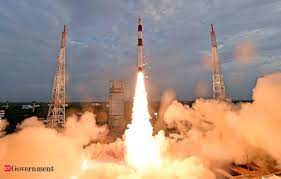
ISRO has transferred its IMS-1 Satellite Bus Technology to Alpha Design Technologies Pvt Ltd., promoting private industry participation in India’s space sector.
- NewSpace India Limited (NSIL), ISRO’s commercial arm, facilitated the technology transfer.
- IMS-1 Satellite Bus is a platform developed by ISRO for cost-effective space access.
- It serves as a versatile vehicle for payloads, enabling tasks like Earth imaging, space science, and remote sensing.
- Weighing around 100 kg and carrying up to 30 kg payload, it features solar arrays generating 330 watts of power and provides accurate pointing capabilities.
- The transfer marks the first instance of ISRO’s satellite bus technologies being shared with private companies.
- This move aims to boost India’s industrial growth, promote technological self-reliance, and encourage private sector participation in space research and exploration.
Nuclear Medicine:

India has expressed its support for South Africa’s Integrated Early Warning systems and Russia’s BRICS Collaboration in Nuclear Medicine
- Nuclear Medicine is a medical speciality that uses radioactive substances to diagnose and treat diseases.
- It involves the use of small amounts of radioactive materials, known as radiopharmaceuticals, which are introduced into the body.
- These substances emit gamma rays that can be detected by specialized cameras to create images of organs and tissues.
- This imaging technique helps in diagnosing various conditions, such as cancer, heart disease, and bone disorders, by providing detailed information about the functioning and structure of internal organs.
- Nuclear medicine treatments involve using radioactive substances to target and destroy specific cells or tissues, such as cancer cells.
Deepor Beel : Anthropogenic Threat

Deepor Beel, a vital wetland in Guwahati, Assam, faces anthropogenic threats despite its protected status. Indigenous names like “beel” signify cultural and ecological connections, with local livelihoods intertwined with the wetland’s resources.
- Efforts to sustainably coexist with the wetland include initiatives by local women who convert water hyacinths into products, offering employment and improving the ecosystem’s health.
- Similarly, “Kumbhi Kagaz” produces biodegradable paper from water hyacinths, enhancing the wetland’s condition and supporting alternative livelihoods.
- The example can be used to highlight how local knowledge and communities can be incorporated into sustainable conservation efforts.
Deepor Beel:
- Situated in the southwest of Guwahati, Assam, Deepor Beel is not only one of the largest freshwater lakes in the region but also holds the distinction of being the state’s sole Ramsar site.
- It’s recognized as an Important Bird Area by Birdlife International and was once a water channel of the Brahmaputra River.
WMO: 2022 State Of The Climate In Asia Report
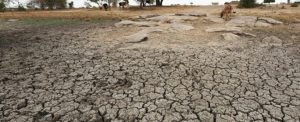
The World Meteorological Organisation (WMO) has come up with its 2022 State of the Climate in Asia report, indicating that in 2022, Asia experienced extreme climate events, including high temperatures, droughts, floods, and cyclones, leading to significant socioeconomic impacts.
Report are:
- The annual mean near-surface temperature in 2022 was 1.15 °C above pre-industrial average
- Ocean heat content reached a new high
- Global mean sea level reached a new high due to ocean warming and ice sheet loss.
- 2022 had the second or third-highest mean surface temperature on record
- Northern Siberia, Central Asia, and Western China experienced above-average temperatures
- Regions in Iraq, Ganges-Brahmaputra Rivers, Korean Peninsula faced precipitation deficits
- South Pakistan, Southeast Asia, and northeast China experienced excessive rainfall
- Central India and the Himalayas recorded high precipitation
- Floods in Pakistan and India displaced millions and damaged agriculture.
- 23 glaciers in High Mountain Asia showed a continued mass reduction
- Urumqi Glacier No 1 in Tien Shan had the second most negative mass balance in 2021-22.
- 25 tropical cyclones formed in the western North Pacific Ocean and the South China Sea
- The Nanmadol typhoon affected Japan, causing evacuation, deaths, and economic damage.
- Severe floods in Pakistan displaced 14% of the population, causing deaths and displacements.
- Heavy monsoon affected Northeast India and Bangladesh, causing deaths and destruction
- Floods were India’s worst natural disaster in 2022
- The Yangtze River basin in China experienced the worst drought in six decades, impacting crops, energy, and economy
- Iran faced its third consecutive year of drought, leading to decreasing water bodies and economic loss.
- Floods in Pakistan, China, and India caused economic losses exceeding the average observed over 20 years
- Droughts in China and Iran resulted in significant economic damages
- Cyclones and storms led to milder economic losses compared to previous years.
Digital India RISC-V (DIR-V) Program:

The Union Minister of Electronics & IT addressed the Digital India RISC-V (DIR-V) Symposium organized by IIT Madras in Chennai.
- The one-day symposium, organized by IIT Madras, emphasized the government’s vision for DIR-V which currently aims to build a robust ecosystem for RISC-V with effective public-private partnerships and collaborations with premiere academic institutions.
- Digital India RISC-V (DIR-V) Program is a forward-looking initiative that aims to uplift India’s semiconductor ecosystem.
- Its primary goal is to promote indigenous innovation in the field of microprocessors, laying the foundation for self-reliance.
- The program emphasizes three key principles: innovation, functionality, and performance, shaping its direction for the future.
- The program acknowledges the increasing demand for silicon chips in today’s digitized world.
- As emerging technologies like 5G and 6G reshape the digital landscape, DIR-V anticipates finding applications in various areas such as cloud services, Internet of Things(IoT), and sensors.
- DIR-V is positioned at the heart of India’s aspirations for high-performance computing.
- Collaborations with organizations like the Center for Development of Advance Computing (C-DAC) and public-private partnerships will ensure that DIR-V plays a pivotal role in these ambitious goals.
Digital Health Incentives Scheme:

National Health Authority (NHA) has announced an extension of its Digital Health Incentives Scheme (DHIS) under the Ayushman Bharat Digital Mission (ABDM).
- The DHIS, offering incentives of up to Rs. 4 crores, has been extended till December 31, 2023.
- Under the Digital Health Incentives Scheme (DHIS), hospitals, diagnostic labs, and digital health solution providers are incentivized to embrace transformative digitization practices.
- The scheme operates with the goal of fostering a digitally inclusive healthcare ecosystem that aligns with the larger vision of Ayushman Bharat Digital Mission.
Eligibility:- Health facilities (hospitals, diagnostic labs) and registered Digital Solution Companies (DSCs) under ABDM’s Health Facility Registry (HFR) are eligible to participate in the scheme.
- The financial incentives are based on the number of digital health records created and linked to Ayushman Bharat Health Account (ABHA) numbers of patients.
- As of June 2023, a total of 1205 health facilities have registered under the DHIS, including 567 public and 638 private hospitals, clinics, and diagnostic labs.
- Among the 25 registered digital solution companies, 22 are from the private sector, demonstrating diverse participation.
Vaquita Porpoise : Extinction Alert
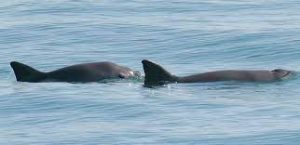
The International Whaling Commission (IWC) issued its first ‘extinction alert’ on the vaquita porpoise.
- Vaquita Porpoise is the world’s smallest cetacean.
- It is unique among the porpoises as it is the only species of that family found in warm waters, and the size of the dorsal fin is believed to be an adaptation to that, allowing for extra body heat to dissipate.
- The name vaquita means “little cow” in Spanish.
- It has the smallest range of any whale, dolphin or porpoise, and only lives in a small 1,500 square-mile area in Mexico’s upper Gulf of California, near the town of San Felipe.
- It has a large dark ring around its eyes and dark patches on its lips that form a thin line from the mouth to the pectoral fins.
- It only measures up to five feet in size.
- The vaquita population has been declining precipitously for decades due to bycatch in gillnet set to catch shrimp and fish, including totoaba.
- Conservation status
- IUCN: Critically Endangered
- CITES: Appendix I
Exercise Malabar 2023:

The 31st edition of the Malabar multilateral exercise will be held off Sydney from August 11-21.
- Exercise Malabar was started in 1992 as a bilateral naval exercise between India and US navy.
- The first Malabar Exercise in the Bay of Bengal took place in 2007.
- It was expanded into a trilateral format with the inclusion of Japan in 2015.
- In 2020, the Australian Navy joined the Malabar Exercise, making it a quadrilateral naval exercise.
- The aim of the Malabar Exercise of India, the US, Japan and Australia is to coordinate for a free, open, and inclusive Indo-Pacific.
- It takes place annually in the Indian Ocean and Pacific Oceans alternatively.
- This exercise includes a diverse range of activities such as fighter combat operations and maritime interdiction operations.
Dicraeosaurid Dinosaur Fossil : Discovered
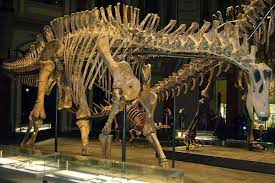
Scientists from IIT-Roorkee and Geological Survey of India (GSI) have discovered the oldest fossil remains of dicraeosaurid dinosaur in Jaisalmer.
- Dicraeosaurid dinosaur is a long-necked, plant-eating dinosaur species.
- The remains are 167 million years old and belong to a new species, unknown to scientists thus far.
- It has been named ‘Tharosaurus indicus’, the first name referring to the ‘Thar desert’ where the fossils were found, and the second after its country of origin.
- According to the scientists, fossils of dicraeosaurid dinosaurs have been found previously in North and South Americas, Africa and China, but such fossils were not known from India.
- The rocks in which the fossils were found are dated to be around 167 million years old, which makes this new Indian sauropod not only the oldest known dicraeosaurid but also globally the oldest diplodocoid (broader group which includes dicraeosaurids and other closely related sauropods).
- Theories so far had suggested that the oldest dicraeosaurid was from China (about 166-164 million years old).
INS Chennai:
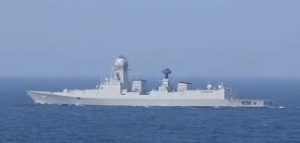
INS Chennai recently deployed in the Red Sea undertook Passage Exercise (Passex) with Royal Saudi Naval Ship HMS Al Jubail.
- INS Chennai is the Indian Navy’s indigenously designed and constructed guided missile destroyer.
- It is the third and last ship of the Kolkata-class stealth-guided missile destroyers (Project 15A).
- It was constructed by the Mazagon Dock Limited (MDL) at Mumbai.
- INS Chennai was commissioned into the Indian Navy on November 21, 2016.
- It measures 163 meters in length and has a beam of 17.4 meters.
- Displacement: Over 7,500 tons.
- Top Speed: 30 knots (approx 55 KM/hour)
- It is powered by four reversible gas turbine engines.
- It can carry 350 to 400 people.
- It is armed with Vertical launch and long-range surface-to-air and surface-to-surface missile systems like supersonic BrahMos, ‘Barak-8’ Long Range Surface to Air missiles.
- The ship is equipped to fight under nuclear, biological and chemical (NBC) warfare conditions.
- It is fitted with a modern Surveillance Radar, which provides target data to the gunnery weapon systems of the ship.
- The ship’s Anti Submarine Warfare capabilities are provided by the indigenously developed Rocket Launchers and Torpedo Launchers.
Perseid Meteor Shower:
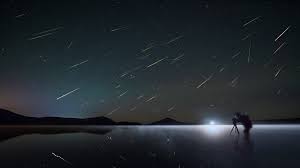
The NASA All Sky Fireball Network is already detecting the first meteors of this year’s Perseid meteor shower
- Meteor Shower is a space rock that comes into Earth’s atmosphere.
- As it falls, the air makes it really hot because of the friction.
- The bright streak we see is not the rock itself, but the hot air around it.
- When many space rocks hit the atmosphere over Earth together, we call it a meteor shower.
- These meteors travel at incredible speeds, reaching tens of thousands of kilometers per hour before disintegrating due to the intense heat generated by friction with the atmosphere.
- Perseid Meteor Shower is one of the most popular and well-known meteor showers that occurs annually.
- It usually takes place in August, specifically around August 11th to 13th, with its peak occurring around August 12th.
- These meteors are fast and bright, leaving trails of light and color behind them as they move through the sky.
- During the Perseids, you can see around 50 to 100 meteors every hour.
- They usually show up when the weather is warm and the nights are comfortable for watching the sky.
- The Perseids are special because they often generate fireballs.
- Fireballs are big bursts of light and color that last longer than a regular shooting star.
- This happens because fireballs come from larger pieces of material from comets.




